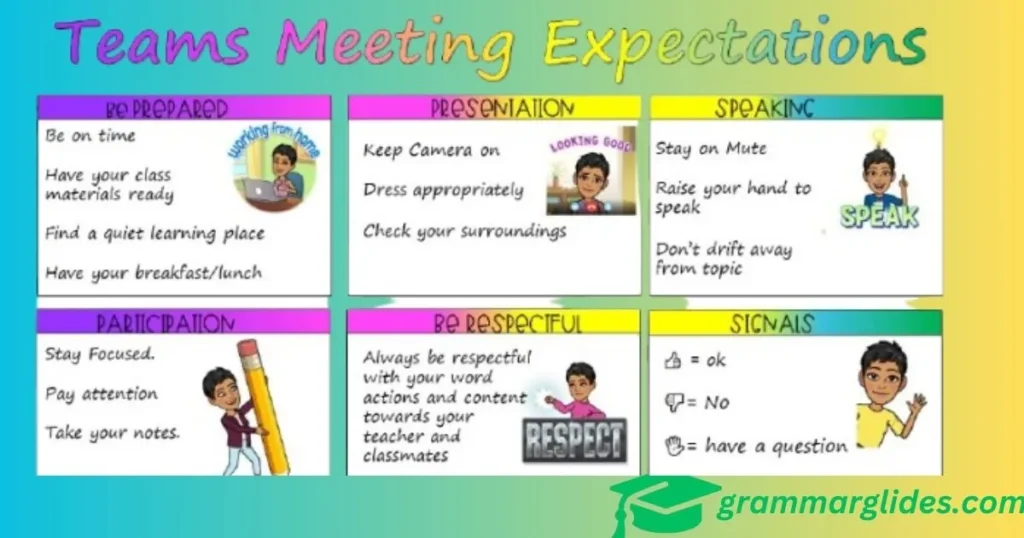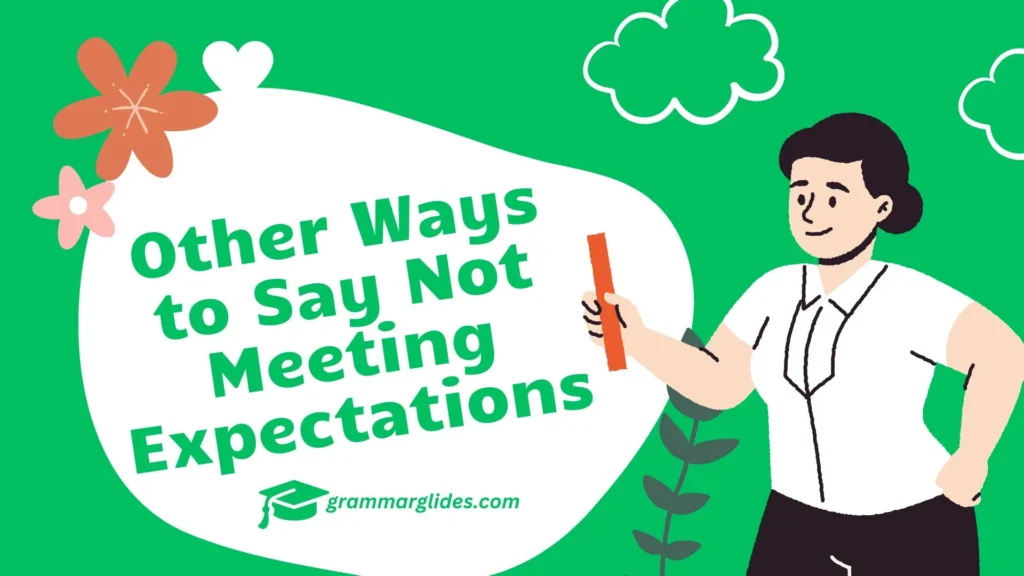“Alternative ways to say “not meeting expectations” without sounding too harsh.”
In any professional or personal context, there are times when performance or outcomes don’t align with the expectations set. Whether it’s a project that didn’t meet goals, a team member whose results were lower than anticipated, or a service that failed to live up to promises, conveying this message requires tact. Rather than simply saying something is “not meeting expectations,” there are many alternative expressions that can help deliver the same message in a more nuanced or constructive manner.
In this article, we’ll explore 25 alternative phrases that can be used in various scenarios to address situations where performance or results were below what was anticipated. These expressions are useful for maintaining professionalism while encouraging improvement or further dialogue.
1. Falling Short of Goals
Scenario: You need to inform someone that their performance did not meet the targets set.
Example 1: “It seems we are falling short of the goals we set for this quarter.”
Example 2: “The results are falling short of what we aimed to achieve.”
Explanation: This phrase conveys that the desired goals were not met while sounding neutral and factual, without pointing fingers.
2. Underperforming
Scenario: Discussing a situation where results or performance are below standard.
Example 1: “The current results are underperforming relative to expectations.”
Example 2: “This project is underperforming in terms of the initial estimates.”
Explanation: “Underperforming” is a clear and neutral way to address performance that doesn’t meet expected standards, leaving room for improvement.
3. Not Up to Standard
Scenario: Noting that a product, service, or result does not meet the expected level.
Example 1: “This report is not up to standard and will need revisions.”
Example 2: “The quality of work provided is not up to standard for this project.”
Explanation: This phrase is a polite way to indicate that the outcome did not meet the anticipated level without sounding overly critical.
4. Below Expectations

Scenario: Informing someone that their output did not meet what was anticipated.
Example 1: “Your presentation was below expectations for this meeting.”
Example 2: “The sales figures for this quarter are below expectations.”
Explanation: This phrase directly addresses the gap between what was expected and what was achieved in a non-confrontational way.
5. Falling Behind Schedule
Scenario: When a task or project is not progressing as expected within the allotted time frame.
Example 1: “The project is falling behind schedule and needs to catch up.”
Example 2: “We are falling behind schedule, so adjustments need to be made.”
Explanation: This phrase indicates that progress is slower than expected, and action is needed to get back on track.
6. Subpar
Scenario: When the quality of something is lower than anticipated.
Example 1: “The recent report was subpar and requires immediate revision.”
Example 2: “The performance of the product was subpar and did not meet industry standards.”
Explanation: “Subpar” is an effective way to express that something is below the expected level of quality.
7. Not Meeting the Criteria
Scenario: Indicating that something doesn’t meet the set standards or conditions.
Example 1: “The product is not meeting the criteria for quality control.”
Example 2: “The performance review shows that the criteria were not met.”
Explanation: “Not meeting the criteria” is a formal and objective way to indicate a shortfall in expected standards.
8. Insufficient Outcome
Scenario: When the result is not sufficient to meet the goals or needs.
Example 1: “The outcome is insufficient to meet the project goals.”
Example 2: “This level of performance is insufficient for this task.”
Explanation: This phrase clearly communicates that the result falls short of what is necessary or expected.
9. Failing to Reach Expectations
Scenario: Addressing when an effort does not achieve the anticipated results.
Example 1: “The marketing efforts are failing to reach expectations.”
Example 2: “The project’s results are failing to reach expectations for quality.”
Explanation: This phrase directly expresses that the outcome did not meet the hoped-for results.
10. Below Par
Scenario: When the level of performance or quality is considered lower than expected.
Example 1: “The event was below par compared to last year’s standards.”
Example 2: “The response to the new product was below par in terms of sales.”
Explanation: “Below par” is a simple way of saying that something was less than what was expected.
11. Lacking the Expected Results
Scenario: When the anticipated results are absent or insufficient.
Example 1: “The marketing campaign is lacking the expected results so far.”
Example 2: “The project is lacking the expected results in terms of delivery.”
Explanation: This phrase communicates that the results didn’t meet the pre-set expectations.
12. Not Up to Expectations
Scenario: When something does not meet the standard of what was anticipated.
Example 1: “The performance was not up to expectations for such an important task.”
Example 2: “The service provided was not up to expectations for our customers.”
Explanation: This is a common and polite way to say that something didn’t quite meet the expected level of quality.
13. Disappointing Results
Scenario: When the outcome is lower than anticipated, leading to disappointment.
Example 1: “The sales figures for the last quarter are disappointing.”
Example 2: “The response to our product was disappointing, and we need to adjust our strategy.”
Explanation: “Disappointing results” clearly communicates a letdown and implies the need for review or change.
14. Not Aligning with Expectations
Scenario: When something does not match the anticipated outcome or vision.
Example 1: “The design is not aligning with the expectations set by the team.”
Example 2: “The current project is not aligning with expectations in terms of its impact.”
Explanation: This phrase shows that there is a disconnect between the expected and actual outcome.
15. Insufficient Performance
Scenario: When the performance level is too low to meet expectations.
Example 1: “The team’s performance is insufficient to achieve the targets for this month.”
Example 2: “We’re seeing insufficient performance in terms of output from this process.”
Explanation: This is a formal way to convey that the performance level is inadequate for the intended purpose.
Other Ways to Say Please Be On Time
16. Not Sufficiently Effective
Scenario: When an effort is ineffective in producing the desired result.
Example 1: “The current approach is not sufficiently effective to meet our goals.”
Example 2: “The solution provided was not sufficiently effective in solving the issue.”
Explanation: This phrase indicates that the approach or outcome lacks the desired impact or efficiency.
17. Below the Desired Outcome
Scenario: When results fall below what was hoped for.
Example 1: “The report is below the desired outcome and requires adjustments.”
Example 2: “The project’s progress is below the desired outcome for this phase.”
Explanation: This phrase expresses that the results were lower than what was intended or hoped for.
18. Unmet Expectations
Scenario: When the outcome or performance fails to meet what was expected.
Example 1: “The product launch has resulted in unmet expectations from our stakeholders.”
Example 2: “The service provided was a case of unmet expectations, and we need to reassess.”
Explanation: This is a direct way to state that the expectations were not fulfilled.
19. Lacking Sufficient Quality
Scenario: When the quality of the work or product is not enough to meet expectations.
Example 1: “The project deliverables are lacking sufficient quality for final approval.”
Example 2: “The quality of the product is lacking in key areas.”
Explanation: This phrase indicates that the quality falls short of the expected standard.
20. Insufficient Results

Scenario: When the results are not adequate to achieve the desired outcome.
Example 1: “The current results are insufficient to meet the target of the campaign.”
Example 2: “The study yielded insufficient results to support the hypothesis.”
Explanation: This communicates that the results were not enough to achieve the intended goal.
21. Not Up to Par
Scenario: When performance or quality doesn’t meet the expected standard.
Example 1: “The results from this quarter are not up to par with our previous benchmarks.”
Example 2: “The customer service response times have been not up to par in recent days.”
Explanation: This phrase indicates that the level of performance or quality is substandard but still polite and professional.
22. Below the Minimum Expectations
Scenario: When the outcome or performance does not meet the bare minimum required.
Example 1: “The report does not meet the minimum expectations for this project.”
Example 2: “This level of output falls below the minimum expectations for this department.”
Explanation: This communicates that the result is not even meeting the basic requirements or standards.
23. Underachieving
Scenario: When someone fails to achieve the expected or required level of success.
Example 1: “The team is underachieving compared to the goals we set at the beginning of the year.”
Example 2: “The project’s performance is underachieving in terms of the targets we outlined.”
Explanation: “Underachieving” highlights that the level of achievement is below what was planned or anticipated.
24. Lackluster Performance
Scenario: When results are uninspiring or do not meet expectations.
Example 1: “The marketing campaign’s response has been lackluster so far.”
Example 2: “The performance during the meeting was lackluster and did not engage the audience.”
Explanation: “Lackluster” is a gentle way to describe something that didn’t perform as expected and is often used for situations that lack enthusiasm or impact.
25. Not Reflecting Our Goals
Scenario: When outcomes do not align with the goals that were set.
Example 1: “The project’s results are not reflecting our original goals and objectives.”
Example 2: “This quarter’s numbers are not reflecting the ambitious goals we set.”
Explanation: This phrase is useful to communicate that the actual results are not in line with the initial aims or targets.
26. Failing to Meet Standards
Scenario: When the performance falls short of the established standards or requirements.
Example 1: “The quality of the product is failing to meet the industry standards.”
Example 2: “The team’s performance is failing to meet the standards we have set for this project.”
Explanation: This phrase is more formal and directly addresses the failure to meet specific standards.
27. Not Delivering Expected Results
Scenario: When something fails to produce the results that were anticipated.
Example 1: “The new software is not delivering the expected results for the department.”
Example 2: “The sales efforts have not been delivering the expected results in terms of growth.”
Explanation: This expression is used to indicate that the output is not yielding the anticipated or desired results.
28. Below Target
Scenario: When performance or results are lower than the set targets.
Example 1: “The marketing results for the month are below target, and adjustments are necessary.”
Example 2: “The current sales figures are below target, so we need to reassess our approach.”
Explanation: “Below target” is a direct and clear way to convey that the performance is not meeting the set goals.
29. Not Meeting Project Requirements
Scenario: When the deliverables or outcomes do not meet the specified project requirements.
Example 1: “The development phase is not meeting the project requirements we outlined.”
Example 2: “The product design is not meeting the required specifications for this launch.”
Explanation: This phrase is used when a particular aspect of a project doesn’t meet the agreed-upon criteria or requirements.
30. Not Living Up to Expectations
Scenario: When something or someone doesn’t perform as expected or promised.
Example 1: “The performance this year is not living up to expectations set in previous meetings.”
Example 2: “The product has not lived up to the high expectations we set for it.”
Explanation: “Not living up to expectations” is a polite and clear way to state that results or performance were not as good as anticipated.
Conclusion
In any professional setting, it’s essential to communicate when results are below expectations. However, how you express this can impact the tone of the conversation and foster a more constructive environment. By using the alternatives listed above, you can communicate shortfalls without sounding harsh. Whether you’re providing feedback to a colleague, a client, or a team, these phrases allow for clear, neutral, and professional discussions about performance and outcomes.

Hi! I’m Lauren Reynolds, the author of Grammar Glides. I create easy-to-follow content that helps you master English with confidence. Let’s make learning English simple and enjoyable together!

